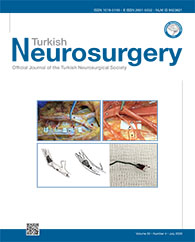Cisterns as Vital Structures: Byzantine Cisterns and Subarachnoid Cisterns
Tayfun HAKAN
1Fatih Sultan Mehmet Teaching and Research Hospital, Neurosurgery Clinic, Istanbul, Turkey
DOI :
10.5137/1019-5149.JTN.29786-20.3
Water is essential for life. It is needed not only to survive but also to sustain daily life activities. The maintenance of daily life activities
related to hygiene as well as prevention of epidemic diseases and accidents involving fire was as important in the past as today.
Powerful empires built many open-air and covered cisterns for water reservation and constructed aqueducts to bring water from
hinterland to these cisterns. The first prototypes of cisterns were constructed in the Neolithic age. Byzantine cisterns such as the
Basilica Cistern and Aqueduct of Valens are excellent examples that are remnants from the past to present.
Similar to these social measures for water preservation, biological structures exhibit their own measures. In the human body,
subarachnoid cisterns of central nervous system are the best-known cisterns, despite the presence of the cisterna chyli and Golgi
body. The central nervous system produces and stores water in the form of cerebrospinal fluid in the subarachnoid cisterns for
mechanical and immunological protection of the anatomical structures and for autoregulation of cerebral blood flow every day. Any
condition that may adversely affect the cisterns, public or subarachnoid, may cause serious and irreversible damage to life. Hence,
we should appreciate the importance of water for life; moreover, ?if there is water there is life? is not a great prophecy.
Keywords :
Byzantium, Cisterna, Cisterna chyli, Golgi body, Subarachnoid cisterna





